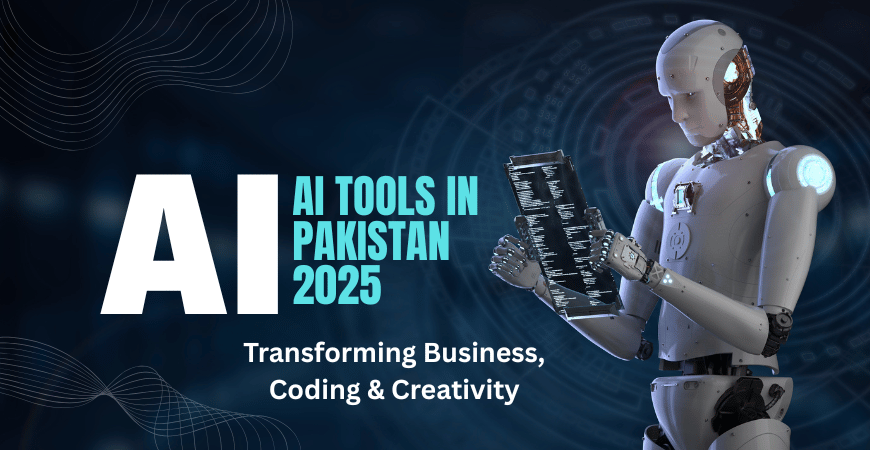AI Tools in Pakistan 2025: Top Trends & Uses
Choosing the Right AI Tools in Pakistan 2025: A Checklist
Artificial intelligence stopped being a toy years ago — in 2025 it’s part of everyday work for creators, entrepreneurs, developers and small businesses across Pakistan. From writing Urdu video scripts to automating customer replies on WhatsApp, Pakistanis are mixing global AI products with local solutions to save time, cut costs and scale creativity. Below I map the most-used categories of AI tools, name the leading examples, explain why Pakistanis love them, and finish with practical tips for choosing the right tool.
1) Conversational AI and large language models (LLMs)
The single biggest shift in 2024–25 has been widespread adoption of LLM-based assistants. ChatGPT (OpenAI) continues to be a cornerstone for content creation, ideation, customer-support prompts and code help — many freelancers and small agencies use it daily for scripts, article drafts, ad copy and translation work. At the same time, competing LLMs such as Google’s Gemini are becoming more accessible through newly introduced, lower-cost plans that expand reach to many countries, making premium AI features more affordable for Pakistani users.
How Pakistanis use them: generate Urdu/roman-Urdu scripts for YouTube, translate product descriptions, draft business emails, and prototype chatbots that later run on WhatsApp or Telegram.
2) AI-assisted coding and developer tools
Developers in Pakistan — both freelancers and product teams — have rapidly adopted AI pair-programming tools like GitHub Copilot. Copilot and similar code assistants speed up repetitive tasks, suggest idiomatic code, and help junior developers learn faster by turning comments into working snippets. This is especially useful for startups and small dev shops where time-to-market matters.
Why it matters locally: With high demand for outsourcing and product development, Copilot boosts productivity and reduces the need to hire for every minor task — a big win for lean Pakistani teams.
3) Content-creation suites (images, video, design)
Creators rely on AI tools that convert ideas to visuals and video faster than traditional workflows. Canva’s AI writing and design features, now supporting more languages and locale-aware templates, have been embraced by Pakistani content creators and marketers who want quick, professional thumbnails, reels and social posts. Similarly, Adobe and other players have rolled out AI-first creative features that simplify video storyboarding and motion design for small teams. These tools minimize the barrier to entry for creators who don’t have expensive editing skills or teams. Lifewire
Common uses: auto-generate Urdu subtitles, design YouTube thumbnails for Urdu videos, create short-form ads, and produce simple social videos from scripts.
4) Chatbots, WhatsApp automation and customer service AI
Businesses — from local shops to e-commerce portals — increasingly deploy chatbots for FAQs, lead capture and order updates. Pakistani firms often connect global chatbot platforms to WhatsApp Business and Telegram; local integrators and agencies then customize flows in Urdu / Roman-Urdu. Platforms that offer easy integration and multi-channel support (web, WhatsApp, Facebook Messenger) are particularly popular.
Use cases: automated order tracking, pre-sales Q&A, booking confirmations, and simple complaint triage — freeing small teams from repetitive messages.
5) Niche localised apps and startups
A vibrant local AI ecosystem is emerging: startups and agencies in Pakistan build tailored solutions (voice-to-Urdu transcription, Urdu OCR, domain-specific chatbots and SME-focused CRMs) that global tools don’t always address. This local layer matters because it adapts AI outputs to cultural context, regional dialects and payment realities (Pakistani billing, mobile wallets). Industry listings and directories in 2025 show many Pakistani AI consultancies and product shops ready to implement customised solutions.
6) Marketing, SEO and productivity AI
Marketers and content teams use AI tools for keyword research, meta-description and ad-copy generation, and performance prediction. Tools that combine SEO guidance with AI writing help creators produce Urdu and English content that ranks faster. Freelancers bundling content + AI tools are common on marketplaces where clients want quick turnaround and low cost.
Concerns Pakistanis still care about (and how they cope)
-
Language fidelity: models trained mostly on English can make awkward Urdu translations; creators post-edit AI output or use Urdu-focused tools and plugins.
-
Cost & subscriptions: users balance free tiers with cheap regional plans (new low-cost AI subscriptions are changing access).
-
Data privacy & compliance: businesses avoid uploading sensitive customer data to unknown third-party AI services; many choose on-prem or enterprise contracts for critical processes.
-
Quality control: humans remain essential for fact-checking, cultural sensitivity, and final editing — particularly for brand messaging and legal content.
Practical checklist: pick the right AI tool in 2025
-
Define the job. Is it translation, image creation, code help, or customer replies? Match the tool to the job, not the brand.
-
Language support. If you need Urdu/Roman-Urdu, verify native support or test the output quality with real examples.
-
Integration needs. For WhatsApp or e-commerce workflows, prefer platforms with native connectors or a local integrator.
-
Cost vs scale. Start with free tiers for ideation; switch to paid plans only when the ROI (time saved, revenue generated) is clear.
-
Data controls. For customer data, prefer services with clear data policies or enterprise-level privacy options.
-
Skill availability. Choose tools your team can learn quickly — local community tutorials and freelancers can speed adoption.
Final thoughts — opportunity and realism
In 2025 Pakistanis use an ecosystem of global LLMs, creative assistants and localised startups — a blended approach that leverages world-class models while solving regional gaps (Urdu, payments, WhatsApp integration). The result: faster content cycles, more scalable support for small businesses, and new income streams for creators and developers. But AI is best treated as a collaborator — not a replacement — and the smartest teams combine AI speed with human judgment.
Read Also: Best Classified Ads Website in Pakistan 2025



